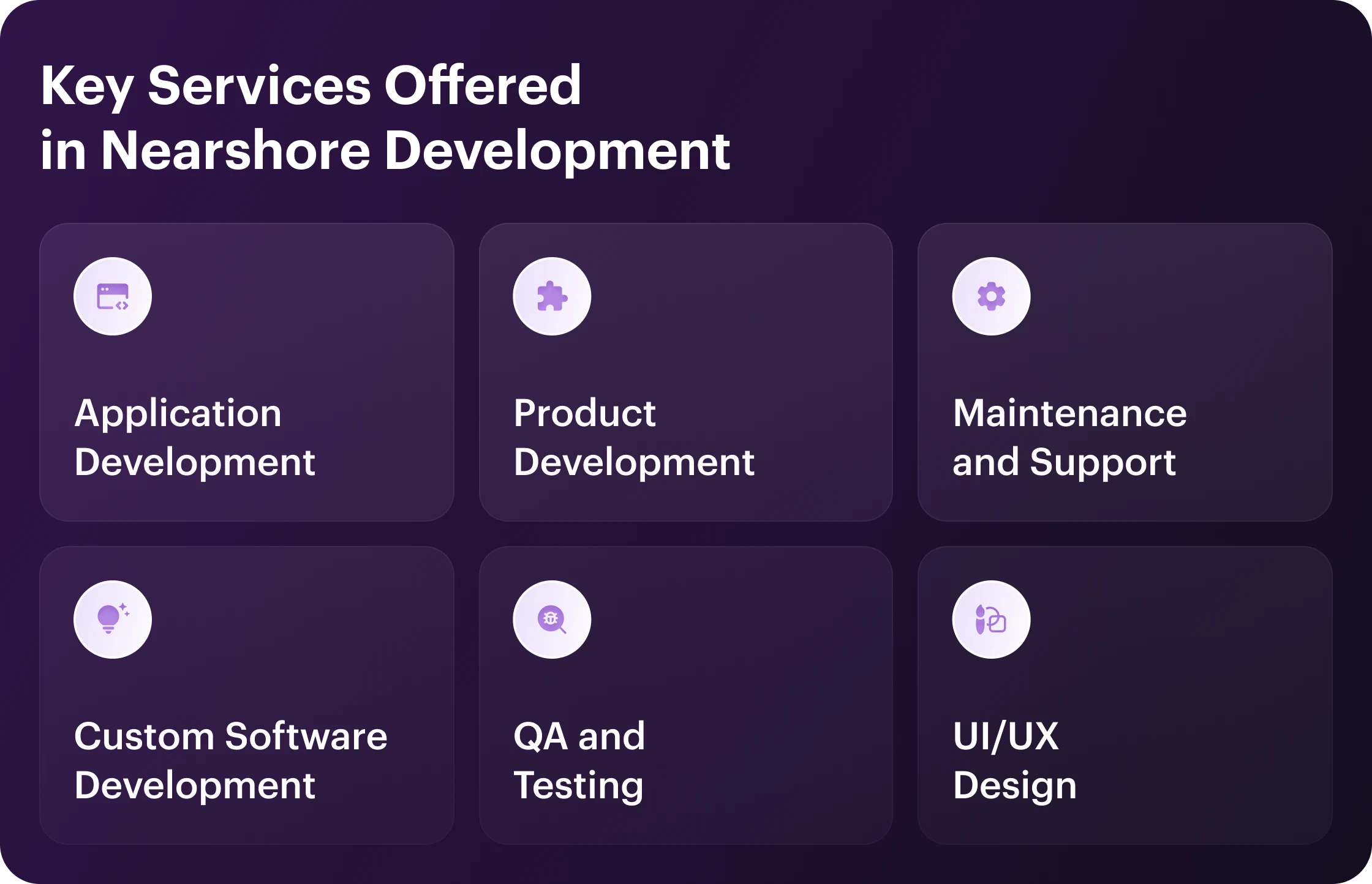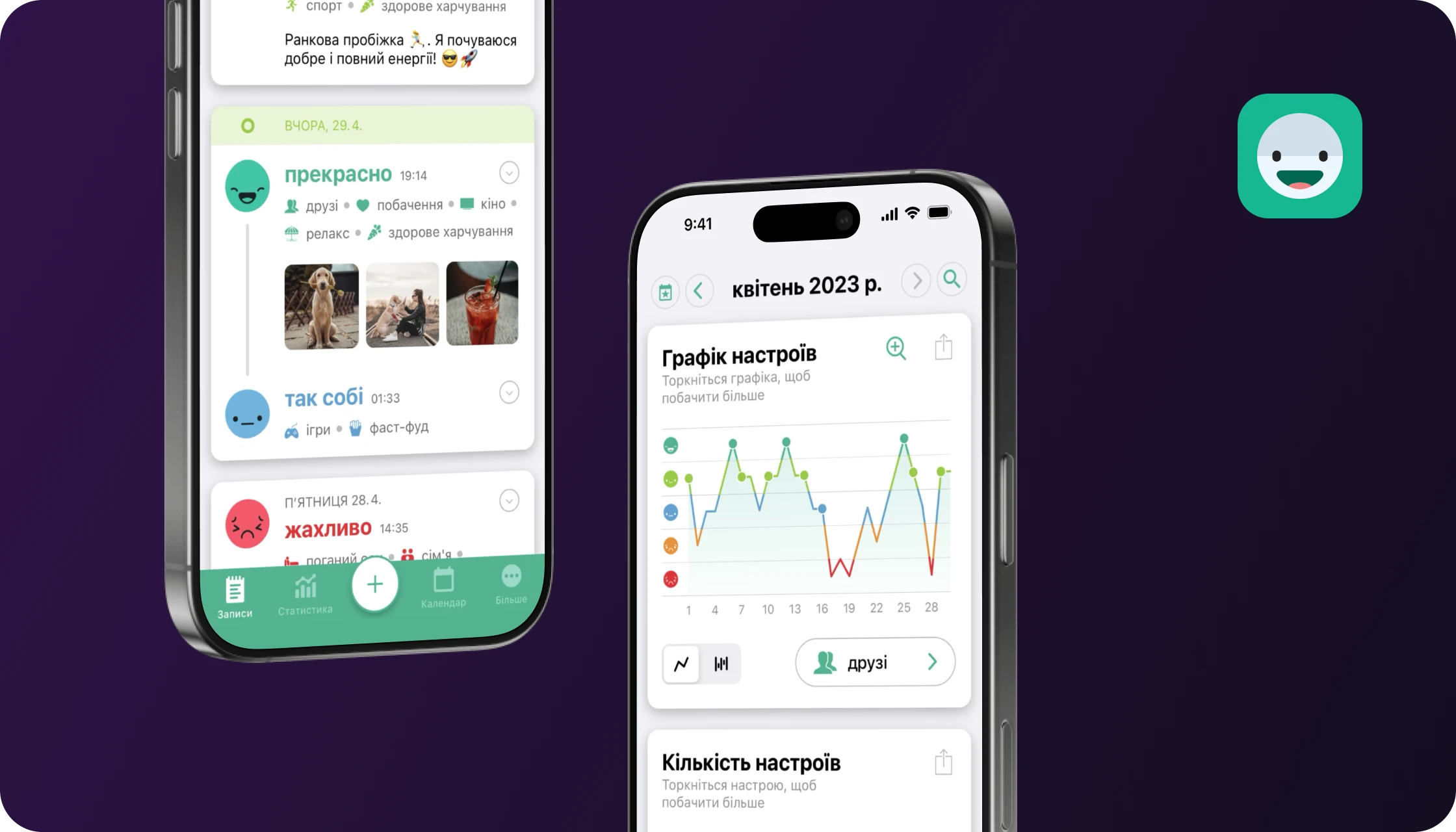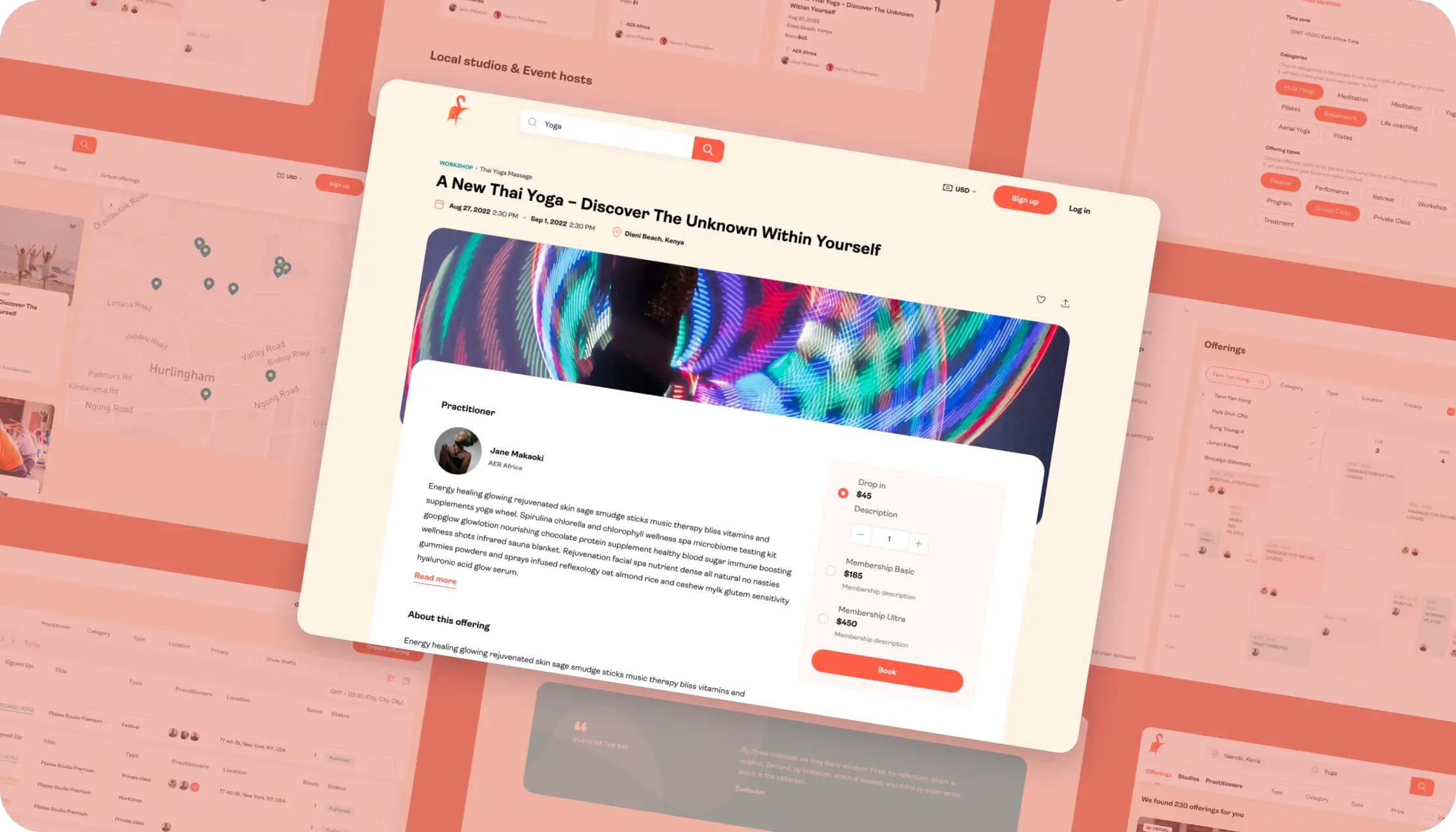Nearshore Software Development Guide

Forbes claims the global nearshore software development services market could exceed $425 billion by 2026. Meanwhile, Forrester reveals that 39% of technology leaders are set to boost their nearshore spending, tapping into cost savings, expert skills, and geographic advantages.
The message is clear: nearshoring is here to stay. To break it down, we've outlined what nearshore software development means, its key benefits, and the signs that indicate it's time to make the switch. Let's dive in.
What is Nearshore Development Services?
Nearshore software development is an outsourcing model where companies contract app developers in a nearby country for their software projects to a third-party team in nearby countries, i.e., a country within 1-4 time zones.
How Does Nearshore Outsourcing Work?
Nearshore software outsourcing kicks off with evaluating your business processes. This allows you to spot tasks that could benefit from external expertise. After these functions are precise, set specific and measurable goals for your outsourcing project. It will guide you in finding a nearshore partner in a neighboring country.
Pick a nearby country that meets your project needs. Focus on cultural fit, language abilities, and needed technical skills. Consider the reputation, client reviews, and ability to deliver high-quality nearshore software development services. Try Clutch or Goodfirms, get referrals from your industry peers, or attend IT events to find potential vendors of nearshore development.
After you've picked the right partner, work out a detailed contract. It must outline the scope of work, timelines, deliverables, and performance metrics.
Then comes a careful transition. It features knowledge transfer and system integration, which helps ensure a smooth handover of responsibilities. Collaboration stays strong with practical communication tools and regular performance reviews. This approach fine-tunes the process and boosts strategic efficiency.

Finally, check on the completed project being delivered on schedule. It should meet the specifications and quality standards you discussed from the start, reflecting the collaboration you've built.
Advantages of Nearshore Software Development Outsourcing
Nearshore outsourcing delivers world-class software development without offshore complications. Shared time zones, cultural alignment, and easy access make it a no-brainer for businesses that want speed and agility. Read on below for more benefits of this outsourcing model:
Cost-Effectiveness
While nearshore software outsourcing may come with a higher price tag than offshore options, it offers superior quality at a reasonable cost. This model reduces travel expenses for meetings and minimizes time zone coordination costs.
For example, in healthcare, nearshore teams develop compliance-driven software without incurring the high costs typical of local development, while in manufacturing, cost-efficient nearshore solutions enhance automation and streamline supply chain management.
Cultural and Time Zone Alignment
Nearshore development teams often share similar work ethics and legal frameworks with their clients, which is particularly beneficial in industries like banking. This alignment ensures smoother regulatory compliance when handling sensitive financial transactions.
In retail, understanding regional consumer behavior is crucial for developing user-friendly e-commerce platforms. Overall, this model naturally boosts better communication and more efficient collaboration.
Access to Skilled Talent
Nearshore hubs offer a rich talent pool with expertise in niche technologies. In fintech, developers ensure secure payment processing, while gaming benefits from advanced AI and graphics specialists. Strong STEM education and digital infrastructure in Latin America and Eastern Europe produce skilled developers who bring fresh perspectives and cutting-edge solutions.
Faster Time to Market
Nearshore software outsourcing shortens development cycles and accelerates time to market. Startups launch MVPs faster while telecom firms roll out software updates seamlessly. Shared time zones enable real-time feedback and problem-solving, keeping development agile and release cycles efficient.
Increased Security & IP Protection
Nearshore outsourcing provides greater legal protection compared to offshore options. In biotech and pharmaceuticals, it ensures data security when handling sensitive research information. In cybersecurity, nearshore teams enhance compliance with local data protection laws.
Nearshore vs. Other Software Development Models

Nearshore software development involves collaborating with teams in neighboring countries, usually within the same or similar time zones.
On the other hand, offshore software development is when companies hire development teams from other countries. These teams are usually located in different time zones. This model often results in lower labor costs, so it's a great choice for businesses aiming to save money.
And lastly, onshore means outsourcing software development to teams in the same country. This approach makes communication easier and ensures a better cultural fit, but it often comes with higher costs than nearshore or offshore options.
This closeness leads to better communication and collaboration, resulting in quicker feedback and more efficient project management while being more cost-effective than local hiring. Here is a breakdown of the main differences:
Nearshore vs Offshore vs Onshore: Key Differences

Key Services Offered in Nearshore Development
Looking for efficient and cost-effective software development? Nearshore teams provide top-tier services that capitalize on proximity, clear communication, and affordability, including:
Nearshore Application Development
This service focuses on developing mobile, web, or desktop applications. Nearshore developers can handle all stages of nearshore application development, from design to deployment, ensuring that applications are user-friendly and meet market demands.
Nearshore Product Development
Nearshore teams can manage the entire software product development lifecycle, including conceptualization, design, coding, testing, and launch. This service is ideal for companies creating complex software products without extensive in-house resources.
Nearshore QA and Testing
Quality assurance and testing services delivered through nearshore teams provide comprehensive coverage across manual and automated testing needs. Nearshore development services include functional testing, performance testing, security testing, and test automation implementation. Nearshore QA teams work in parallel with development cycles, ensuring rapid feedback and issue resolution. The shared time zones facilitate real-time bug reporting and verification, leading to faster quality improvements.
Nearshore Custom Software Development
This involves creating tailored software solutions to meet specific business requirements. Nearshore teams can develop software from scratch or enhance existing systems to improve functionality and efficiency.
Nearshore App Development
Mobile development services through nearshore teams cover both iOS and Android platforms, delivering native and cross-platform solutions. Services include nearshore app development, app modernization, and mobile-first transformations. Teams specialize in creating responsive, user-friendly applications while ensuring optimal performance and security. The collaborative timezone allows for swift iterations based on user feedback and market demands.
Nearshore UI/UX Design
Nearshore design teams provide comprehensive UI/UX services aligned with current nearshore development market trends and user expectations. Services include user research, wireframing, prototyping, and interactive design implementation. The proximity enables regular design reviews and quick iterations based on stakeholder feedback. Teams work closely with developers to ensure design integrity throughout implementation.
Nearshore Maintenance and Support
Maintenance and support services through nearshore teams ensure continuous system reliability and performance. Services cover bug fixes, speed improvements, security patches, and new features. The shared time zone allows for responsive support during business hours and efficient handling critical issues. Teams provide both scheduled maintenance and emergency support to maintain system stability.

When Do You Need a Nearshore Development Company?
While nearshore outsourcing offers numerous benefits, the real question is: When is the right time to switch to nearshore outsourcing? Typically, organizations turn to nearshore in times of operational hurdles. But the reasons don't end here.
Let's examine the situations that suggest your company might be ready for this transition.
Operational focus shifts away from core business needs.
As projects grow, your team may become overwhelmed, losing focus on core priorities. When that happens, it's time to reassess your strategy. This is where a nearshore software development partner can step in. For companies where software isn't a primary function, nearshore teams provide the support needed to maintain balance, ensuring that business goals and development demands align seamlessly.
Challenging resource allocation.
Finding the right software developers can be challenging if you don't have an in-house tech team. It's become even trickier when there isn't much local talent available. Some companies use freelancers or various outsourcing vendors to fill gaps. This is where nearshore development offers a better overall solution.
You have budget constraints.
If building an in-house tech team is too costly, nearshore development offers a practical alternative. Companies can scale efficiently with access to skilled developers in cost-effective regions like Central & Eastern Europe or Latin America. A nearshore partner also ensures proper resource allocation, allowing you to integrate developers into your team while controlling costs seamlessly.
Your business is scaling fast.
Expanding into new markets, businesses often need additional resources at short notice. This is particularly true for startups experiencing rapid growth. A nearshore development partner provides an efficient way to scale, offering access to top-tier developers who can tackle rising workloads and pressing projects. With vast talent networks, nearshore teams ensure seamless expansion.
How to Choose the Best Nearshore Development Partner
Basically, when you choose a nearshore software development company, start with your project needs. Then, check the developer's skills and credentials. Also, consider their way of working, how well they fit your culture, and how they communicate. The steps to finding the best fit for the project don't end here. Below, we share a detailed overview of practical ways to find the right one:
1. Clarify Your Project Scope.
The truth is, there are no two businesses alike, even in the same niche. Yet, their challenges differ, too. Before reaching out to nearshore software development teams, define your project needs.
To help vendors provide accurate proposals, include some deal-breaking questions in your Request for Proposal (RFP):
- What is the scope of your project? (e.g., building from scratch or post-release support)
- What specific tech stack does your project require?
- Are you looking to hire an individual developer or an entire team?
2. Research Nearshore Developer Candidates.
Nearshore software developers are easy to find. Yet, without proper vetting, you risk delays, miscommunication, and subpar work. Do your homework. Find candidates with the right skills, experience, and work style to fit seamlessly into your team.
You can find potential nearshore software developers by:
- Google Search. Search for "software developers" + [specific country] to find potential candidates. Then, review their websites to assess their IT services, expertise, and past projects.
- Specialized Directories. Clutch features company profiles, service offerings, and client reviews, while GoodFirms highlights vendor portfolios with visuals.
- LinkedIn. Search for nearshore development services, then narrow down by region and sector.
- Professional Networks. Seek referrals from trusted peers and leverage proven partnerships.
- IT Events. Join international or regional tech events to network with nearshore developers.
3. Verify the Developer's Credentials.
Never skip due diligence when hiring a developer. First, check their portfolio—real expertise is backed by real work—if it's missing, move on. Next, scan reviews on Clutch. Delays, misaligned projects, or budget overruns are red flags. A history of satisfied clients points to a dependable vendor.
4. Evaluate Collaboration Methods.
Nearshore outsourcing relies on structured workflows, not just shared time zones. Ask vendors how they communicate and track progress. Many use Trello, Slack, or Jira to update clients and gather feedback, but tools alone aren't enough. A solid workflow ensures efficiency and adaptability. Plus, discuss how they measure progress and refine products. A clear process minimizes miscommunication and keeps your project on track.
5. Check On Cultural Fit and Communication.
Nearshoring often offers cultural and language similarities, but there are some exceptions. Even neighboring countries can have unique work styles and languages.
For instance, Australia is 3 hours ahead of China. So, China could be a good nearshoring choice. Yet, there's a catch: many Chinese developers lack fluency in English, and their working methods can differ significantly. Therefore, for Australian clients, turning to European software companies proves to be a smarter choice, promoting smoother communication and a collaborative spirit.
6. Interview the Software Developer.
Communication can derail your project even with shared language, time zones, and culture. Therefore, an in-person interview is critical. It allows you to assess the project manager's or business lead's responses, revealing potential red flags.
Treat this interview as a deep dive into the nearshore developer's expertise. Extract insights before committing. Hiring is a long-term investment; mitigating risks upfront is essential.
These questions will help you determine if the candidate is the right fit:
- What development methods do you use?
- How do you keep communication clear with clients?
- What tech stack and tools does your team specialize in?
- How do you find and fix issues during development?
- What roles and skills are needed when assembling a team for my project?
Best Nearshore Locations
Below is an overview of the best nearshore software outsourcing locations across Latin America (LATAM), Eastern Europe, and Asia, including descriptions, hourly rates, and relevant statistics.
Best Nearshore Locations in LATAM
LATAM offers skilled, cost-effective outsourcing with convenient time zones. Here is a list of top nearshore LATAM destinations:
1. Mexico
Known as North America's nearshore powerhouse, Mexico offers proximity to the U.S., cultural alignment, and a large talent pool of 220,000 tech professionals. Its bilingual workforce and growing IT sector make it a top choice for nearshore software development and IT outsourcing.

2. Brazil
Brazil is LATAM's largest economy and a leader in AI, fintech, and cloud computing. With over 500,000 developers, it is ideal for companies seeking expertise in advanced technologies.

3. Argentina
Argentina excels in English proficiency (ranked #1 in LATAM) and has a strong remote work culture. It is a cost-effective option for high-quality software development.

4. Colombia
Colombia is a rapidly growing IT outsourcing hub with government investments in STEM education. It specializes in nearshore app development, data analysis, and cybersecurity.

Best Nearshore Locations in Eastern Europe
Skilled talent, low costs, and tech expertise make this region a prime outsourcing hub. Here is the list of nearshore destinations in Eastern Europe:
1. Ukraine
Ukraine remains a strong outsourcing hub, and offers expertise in web nearshore development, mobile apps, AI, and blockchain.

2. Poland
Poland is recognized for its high-quality tech talent and strong English proficiency (ranked #16 globally). It offers robust expertise in software engineering and financial technology.

3. Moldova
Moldova is an emerging outsourcing destination with affordable rates and a growing reputation in web nearshore development and cross-platform mobile apps. Its Digital Moldova 2030 strategy supports IT growth.

4. Baltic States (Estonia, Latvia, Lithuania)
Estonia:
Known as the "Digital Society Architect," Estonia excels in secure digital systems and e-governance solutions.

Latvia:
Specializes in data engineering services with a startup-friendly ecosystem.

Lithuania:
A FinTech hub with expertise in blockchain and semiconductor manufacturing.

Best Nearshore Locations in Asia
With strong English proficiency, diverse talent pools, and growing innovation hubs, Asia remains a top choice for businesses seeking efficiency and scalability. Read on for the top nearshore locations in Asia.
India
Offers the most vast talent pool and expertise in advanced technologies like AI, blockchain, IoT, and cloud computing. Cities like Bangalore, Hyderabad, and Pune are renowned IT hubs with strong infrastructure and government support for foreign investors.

Philippines
The Philippines is home to over 1,000 IT-BPO companies and ranks highly for cultural alignment with Western businesses. It excels in customer service outsourcing and mobile app development. Its high English proficiency (ranked #2 in Asia) ensures seamless communication with Western clients. Manila is a top global outsourcing hub.

Vietnam
Vietnam's IT sector grows by over 25% annually, supported by government incentives for digital transformation. It specializes in nearshore software development, mobile apps, and e-commerce solutions. Cities like Ho Chi Minh City and Hanoi are tech hubs with growing infrastructure.

China
First, China leads globally in R&D investments and is home to major tech hubs like Shenzhen and Beijing. Moreover, it has a highly skilled workforce with expertise in AI research and hardware development but faces language barriers for Western clients. While language barriers may exist, China remains a top choice for advanced technical projects.

How to Establish a Nearshore Development Center For Long-Term Success
First, set clear, measurable goals and a detailed roadmap outlining growth and scalability for robust, long-term success. Choose a location that provides a rich pool of skilled professionals and aligns with your cultural and operational needs. Invest in state-of-the-art technology and agile project management tools to facilitate continuous feedback and iterative improvement.
By building a flexible framework that can adjust to evolving project demands and industry trends, your nearshore development center will become your organization's sustainable, high-performance extension.
Choosing the Right Nearshore Software Development Outsourcing Partner
Selecting the right outsourcing partner can make or break your project's success. Look for a partner with a strong track record in delivering custom software solutions and proven expertise in your industry.
Key factors include cultural and communication alignment, transparent processes, and a commitment to quality and security standards.
A reliable partner should offer scalable solutions, regular performance reporting, and robust security certifications to protect sensitive data.
You can secure a partner whose technical capabilities and business values align with your long-term objectives by conducting thorough due diligence and engaging in meaningful discussions.
Managing a Nearshore Software Engineering Team Effectively
Establish clear communication channels using collaboration tools like Trello, Jira, or Slack, and schedule regular check-ins to maintain alignment across all teams. Encourage an open environment where feedback is welcomed, and team members feel comfortable sharing insights and challenges.
Regular performance reviews and agile adjustment strategies help maintain high productivity and quality standards. By setting clear expectations and monitoring key performance indicators, you can integrate your nearshore team seamlessly with your in-house staff, driving consistent, exceptional results.
Nearshore Agile Development: The Key to Success
When it comes to "what is agile software development," it refers to a flexible, iterative approach to software development that focuses on collaboration, adaptability, and continuous improvement.
Unlike traditional development methodologies, which follow a linear and rigid process, agile methodologies prioritize frequent customer collaboration, iterative development cycles, and the ability to respond quickly to changes and new requirements.
Key components of nearshore agile development are:
- Individuals and interactions over processes and tools.
- Working software over comprehensive documentation.
- Customer collaboration over contract negotiation.
- Responding to change by following a plan.
These principles emphasize the importance of communication, flexibility, and customer satisfaction throughout development.
Key Benefits of Nearshore Agile Software Development
Outsourcing software development brings clear benefits to businesses—faster time to market, cost optimization, and streamlined process management. But why should you choose nearshore Agile software development specifically? Let's look at four main advantages of this approach:
Adaptability
Agile development turns change into opportunity, refining products through constant iteration. Nearshore teams shift priorities instantly, adapting to market and regulatory needs while keeping development on track.
Cost-effectiveness
Nearshore Agile development helps businesses save money while delivering quality software. Short iterations ensure efficient spending, early feedback prevents costly fixes, and outsourcing cuts infrastructure and HR costs. Companies gain flexibility without unnecessary overhead.
Risks Mitigation
Traditional development risks costly missteps due to changing markets and regulations. Agile nearshoring prevents this with adaptive cycles, continuous testing, and early issue detection, ensuring smoother project execution.
Incremental Delivery
Instead of waiting months for a launch, nearshore Agile teams ship updates continuously. Microreleases and feature toggles ensure that businesses stay responsive, test features live, and quickly improve software.

Darly Solutions' Expertise in Nearshore Development
Using nearshore software development teams has its upsides and downsides. By evaluating them carefully and, most importantly, picking the right partner and nearshore development center, companies can maximize the benefits while tackling the challenges, guaranteeing successful nearshore software development.
That is where Darly Solutions comes into play. We offer a comprehensive suite of custom software nearshore development services, from medical device software to mobile healthcare apps. Enhance operational efficiency, improve patient outcomes, and gain a competitive edge—we are a trusted leader in nearshore software development.
Moreover, we leverage an agile approach combined with robust project management and transparent communication.
This ensures the seamless integration of our team with your in-house strategies. Client testimonials frequently cite our ability to deliver high-quality, cost-effective digital solutions that align with long-term business goals.
Conclusion
No doubt, nearshore software development is ideal for businesses seeking cost efficiency without compromising quality or collaboration. By understanding the key differences between outsourcing models and following best practices for setting up and managing a nearshore team, you can unlock new opportunities for growth and innovation.
Partnering with an experienced provider like Darly Solutions ensures that you have the right expertise and support every step of the way. Embrace the nearshoring model today to stay competitive in the software development landscape tomorrow!
FAQ
Yes, nearshore software development is ideal for startups. It offers cost efficiency, skilled talent, and seamless communication, enabling rapid scaling without offshore delays or high onshore costs.
The cost of nearshore software development depends on where you outsource, the experience level of your team, and your project's needs. On average, hourly rates fall between $25 and $100. Mid-level nearshore software developers may charge $25–$50 per hour, while senior experts can range from $60 to $90 per hour. Overall, nearshore options save 40–65% compared to onshore rates.
A classic nearshoring example is a company in the U.S. outsourcing its nearshore application development to a provider in Latin America, such as in Mexico or Argentina, where operational costs are lower, yet collaboration remains seamless. European companies often turn to Eastern European nations like the Czech Republic for similar reasons.
North American firms frequently turn to Latin America — think Mexico, Costa Rica, Colombia, Brazil, and Argentina—for nearshore software development, while European companies lean toward Eastern Europe, including Poland, Ukraine, Romania, and the Czech Republic.
Connect with us
.webp)
We are a tech partner that delivers ingenious digital solutions, engineering and vertical services for industry leaders powered by vetted talents.


%2520is%2520Revolutionizing%2520the%2520Fintech.webp)













.webp)



